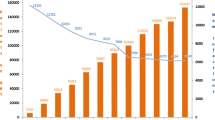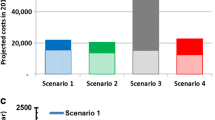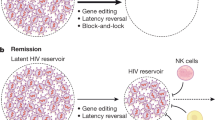Abstract
For the last three decades, sub-Saharan Africa has been the epicentre of the HIV epidemic. Some key drivers of the epidemic are specific to this region and there is an urgent need to develop context-specific strategies to reduce HIV-related burden. Implementation frameworks should endeavour to combine structural, behavioural and biomedical interventions and the future of the HIV response involves embracing different approaches for different populations; it is not ‘one-size fits all approach’. Expanded use of community-based interventions will be key in expanding the role of antiretroviral treatment as prevention (TasP) in the region. For TasP to be effective, high antiretroviral therapy (ART) coverage rates need to be attained. Data from programmatic trials currently underway will provide crucial data to guide the future implementation of TasP.
Similar content being viewed by others
References
Papers of particular interest, published recently, have been highlighted as: • Of importance
Joint United Nations Programme on HIV/AIDS (UNAIDS). The Gap Report. UNAIDS, Geneva, Switzerland. 2014. http://www.unaids.org/en/resources/documents/2014/20140716_UNAIDS_gap_report. Accessed 9 Oct 2014.
Vermund SH, Fidler SJ, Ayles H, Beyers N, Hayes RJ. Can combination prevention strategies reduce HIV transmission in generalized epidemic settings in Africa? The HPTN 071 (PopART) study plan in South Africa and Zambia. J Acquir Immune Defic Syndr. 2013;63 Suppl 2:S221–7.
Kurth AE, Celum C, Baeten JM, Vermund SH, Wasserheit JN. Combination HIV prevention: significance, challenges, and opportunities. Curr HIV/AIDS Rep. 2011;8(1):62–72.
Joint United Nations Programme on HIV/AIDS. UNAIDS. FAST-TRACK: ending the AIDS epidemic by 2030. Geneva: Joint United Nations Programme on HIV/AIDS; 2014.
United Nations. The millennium development goals report 2012. New York: United Nations; 2012.
Delva W, Abdool Karim Q. The HIV epidemic in Southern Africa - Is an AIDS-free generation possible? Curr HIV/AIDS Rep. 2014;11(2):99–108. There are persistent high HIV prevalence rates amongst women aged 15–24 in SSA.
Gouws E, Cuchi P. Focusing the HIV response through estimating the major modes of HIV transmission: a multi-country analysis. Sex Transm Infect. 2012;88 Suppl 2:i76–85.
UNAIDS. Global report on the AIDS epidemic 2013. Geneva: UNAIDS; 2013.
Larmarange J, Wade AS, Diop AK, Diop O, Gueye K, Marra A, et al. Men who have sex with men (MSM) and factors associated with not using a condom at last sexual intercourse with a man and with a woman in Senegal. PLoS One. 2010;5(10):e13189.
Beyrer C, Trapence G, Motimedi F, Umar E, Iipinge S, Dausab F, et al. Bisexual concurrency, bisexual partnerships, and HIV among Southern African men who have sex with men. Sex Transm Infect. 2010;86(4):323–7.
Schwartlander B, Stover J, Hallett T, Atun R, Avila C, Gouws E, et al. Towards an improved investment approach for an effective response to HIV/AIDS. Lancet. 2011;377(9782):2031–41. Global health funders need to be strategic in targeting populations in high burden regions based on disease epidemiology. A human rights approach that maximises community mobilisation may be effective.
Ross DA. Behavioural interventions to reduce HIV risk: what works? AIDS (London, England). 2010;24 Suppl 4:S4–14.
Cremin I, Nyamukapa C, Sherr L, Hallett TB, Chawira G, Cauchemez S, et al. Patterns of self-reported behaviour change associated with receiving voluntary counselling and testing in a longitudinal study from Manicaland, Zimbabwe. AIDS Behav. 2010;14(3):708–15.
Bello G, Simwaka B, Ndhlovu T, Salaniponi F, Hallett TB. Evidence for changes in behaviour leading to reductions in HIV prevalence in urban Malawi. Sex Transm Infect. 2011;87(4):296–300.
WHO. Speech of Dr Luis Gomes Sambo, Regional Director of WHO at the opening ceremony of the International Conference on AIDS and other Sexually Transmitted Infections in Africa – ICASA: WHO’s New HIV Treatment and Prevention Guidelines – What they Mean for Africa. Cape Town, South Africa, 7th December 2013. http://www.afro.who.int/fr/mali/mali-publications/3956-speech-of-dr-luis-gomes-samboregional-director-of-who-at-the-opening-ceremony-of-the-international-conference-on-aids-and-othersexually-transmitted-infections-in-africa--icasa.html. Accessed 14 Jan 2014.
Hayes R, Watson-Jones D, Celum C, van de Wijgert J, Wasserheit J. Treatment of sexually transmitted infections for HIV prevention: end of the road or new beginning? AIDS (London, England). 2010;24 Suppl 4:S15–26.
Auvert B, Males S, Puren A, Taljaard D, Carael M, Williams B. Can highly active antiretroviral therapy reduce the spread of HIV?: A study in a township of South Africa. J Acquir Immune Defic Syndr. 2004;36(1):613–21.
Lewis DA. HIV/sexually transmitted infection epidemiology, management and control in the IUSTI Africa region: focus on sub-Saharan Africa. Sex Transm Infect. 2011;87 Suppl 2:ii10–3.
Alam N, Chamot E, Vermund SH, Streatfield K, Kristensen S. Partner notification for sexually transmitted infections in developing countries: a systematic review. BMC Public Health. 2010;10:19.
Fidler S, Bock P. Prophylactic antiretroviral HIV therapy prevents infection in heterosexual men and women. Evid Based Med. 2013;18(5):184–5.
Quinn TC, Wawer MJ, Sewankambo N, Serwadda D, Li C, Wabwire-Mangen F, et al. Viral load and heterosexual transmission of human immunodeficiency virus type 1. Rakai Project Study Group. N Engl J Med. 2000;342(13):921–9.
Cohen MS, Chen YQ, McCauley M, Gamble T, Hosseinipour MC, Kumarasamy N, et al. Prevention of HIV-1 infection with early antiretroviral therapy. New Engl J Med. 2011;365(6):493–505. HPTN 052, a RCT, showed a 96 % reduction in HIV transmission amongst discordant couples but evidence for effectiveness of this approach in reducing HIV incidence from community trials is limited.
Tanser F, Barnighausen T, Grapsa E, Zaidi J, Newell ML. High coverage of ART associated with decline in risk of HIV acquisition in rural KwaZulu-Natal, South Africa. Science (New York, NY). 2013;339(6122):966–71. Increased ART coverage in a programmatic setting is associated with decreased HIV incidence.
Granich RM, Gilks CF, Dye C, De Cock KM, Williams BG. Universal voluntary HIV testing with immediate antiretroviral therapy as a strategy for elimination of HIV transmission: a mathematical model. Lancet. 2009;373(9657):48–57.
Cori A, Ayles H, Beyers N, Schaap A, Floyd S, Sabapathy K, et al. HPTN 071 (PopART): a cluster-randomized trial of the population impact of an HIV combination prevention intervention including universal testing and treatment: mathematical model. PLoS One. 2014;9(1):e84511.
Rosen S, Fox MP. Retention in HIV care between testing and treatment in sub-Saharan Africa: a systematic review. PLoS Med. 2011;8(7):e1001056.
Gulick RM. Case-based discussion held in collaboration with the International Antiviral Society-USA (ISA-USA) When to start ART and what to start. Glasgow: HIV Drug Therapy Glasgow meeting; 2014.
Lockman S, Sax P. Treatment-for-prevention: clinical considerations. Curr Opin HIV AIDS. 2012;7(2):131–9.
National Institutes of Health. Early antiretroviral treatment and/or early isoniazid prophylaxis against tuberculosis in HIV-infected adults (ANRS 12136 TEMPRANO). Washington: National Institute for Health; 2007.
Babiker AG, Emery S, Fätkenheuer G, Gordin FM, Grund B, Lundgren JD, et al. Considerations in the rationale, design and methods of the Strategic Timing of Anti-Retroviral Treatment (START) study. Clinical Trials. 2013;10(1 suppl):S5–S36.
Sterne JA, May M, Costagliola D, de Wolf F, Phillips AN, Harris R, et al. Timing of initiation of antiretroviral therapy in AIDS-free HIV-1-infected patients: a collaborative analysis of 18 HIV cohort studies. Lancet. 2009;373(9672):1352–63.
Kitahata MM, Gange SJ, Abraham AG, Merriman B, Saag MS, Justice AC, et al. Effect of early versus deferred antiretroviral therapy for HIV on survival. N Engl J Med. 2009;360(18):1815–26.
Geffen N RM, Venter F& Low M. One size doesnt fit all: Tailoring adult antiretriviral treatment South African Journal of HIV Medicine. 2014 15(3). A more individualistic approach to ART provision regardless of CD4 count and WHO stage may be more effective than current standardised guidelines.
Turashvili M, Becher H, Kerschberger B, Jouquet G, Browne M, Haye JL, et al. Decentralisation of HIV/TB care in Shiselweni region of Swaziland: making a difference. Vienna Evaluation Unit. 2014. http://hdl.handle.net/10144/325599. Accessed 9 Jan 2014.
Hayes R, Ayles H, Beyers N, Sabapathy K, Floyd S, Shanaube K, et al. HPTN 071 (PopART): rationale and design of a cluster-randomised trial of the population impact of an HIV combination prevention intervention including universal testing and treatment - a study protocol for a cluster randomised trial. Trials. 2014;15(1):57.
U.S National Institutes of Health. Sustainable East Africa Research in Community Health (SEARCH) trial; Clinical Trials.gov Identifier: NCT01864603, 26 April 2013 ed. U.S. https://clinicaltrials.gov/show/NCT01864603. Accessed 31 Mar 2015.
US National Institutes of Health. Botswana Combination Prevention Project (BCPP); Clinical Trials.gov Identifier: NCT01965470, October 2013 ed U.S. https://clinicaltrials.gov/ct2/show/NCT01965470. Accessed 1 Apr 2015.
Iwuji C, Orne-Gliemann J, Tanser F, Boyer S, Lessells R, Lert F, et al. Evaluation of the impact of immediate versus WHO recommendations-guided antiretroviral therapy initiation on HIV incidence: the ANRS 12249 TasP (Treatment as Prevention) trial in Hlabisa sub-district, KwaZulu-Natal, South Africa: study protocol for a cluster randomised controlled trial. Trials. 2013;14(1):230.
Stop AIDS now. MaxART Immediate Access to ART Implementation Study. Amsterdam: Stop AIDS now!. 2011. http://www.aids.harvard.edu/img/conferences/current/TasP/Okello.pdf. Accessed 3 Apr 2015.
US National Institutes of Health. Early HIV Therapy in Patients With High CD4 Cell Counts (EARLI) ClinicalTrials.gov Identifier: NCT01479634, October 2014 ed U.S. https://clinicaltrials.gov/ct2/show/NCT01479634. Accessed 2 Apr 2015.
Labhardt ND, Motlomelo M, Cerutti B, Pfeiffer K, Kamele M, Hobbins MA, et al. Home-based versus mobile clinic HIV testing and counseling in rural Lesotho: a cluster-randomized trial. PLoS Med. 2014;11(12):e1001768.
Sweat M, Morin S, Celentano D, Mulawa M, Singh B, Mbwambo J, et al. Community-based intervention to increase HIV testing and case detection in people aged 16-32 years in Tanzania, Zimbabwe, and Thailand (NIMH Project Accept, HPTN 043): a randomised study. Lancet Infect Dis. 2011;11(7):525–32.
Suthar AB, Ford N, Bachanas PJ, Wong VJ, Rajan JS, Saltzman AK, et al. Towards universal voluntary HIV testing and counselling: a systematic review and meta-analysis of community-based approaches. PLoS Med. 2013;10(8):e1001496.
Napierala Mavedzenge S, Baggaley R, Corbett EL. A review of self-testing for HIV: research and policy priorities in a new era of HIV prevention. Clin Infect Dis. 2013;57(1):126–38.
Choko AT, Desmond N, Webb EL, Chavula K, Napierala-Mavedzenge S, Gaydos CA, et al. The uptake and accuracy of oral kits for HIV self-testing in high HIV prevalence setting: a cross-sectional feasibility study in Blantyre. Malawi. PLoS Med. 2011;8(10):e1001102.
Cornell M, Grimsrud A, Fairall L, Fox MP, van Cutsem G, Giddy J, et al. Temporal changes in programme outcomes among adult patients initiating antiretroviral therapy across South Africa. AIDS (London, England). 2010;24(14):2263–70.
Bemelmans M, Baert S, Goemaere E, Wilkinson L, Vandendyck M, van Cutsem G, et al. Community-supported models of care for people on HIV treatment in sub-Saharan Africa. Trop Med Int Health. 2014;19(8):968–77.
Ford N, Mills EJ. Simplified ART delivery models are needed for the next phase of scale up. PLoS Med. 2011;8(7):e1001060.
Jones A, Cremin I, Abdullah F, Idoko J, Cherutich P, Kilonzo N, et al. Transformation of HIV from pandemic to low-endemic levels: a public health approach to combination prevention. Lancet. 2014;384(9939):272–9.
Compliance with Ethics Guidelines
Conflict of Interest
Kwame Shanaube and Peter Bock declare that they have no conflict of interest.
Human and Animal Rights and Informed Consent
This article does not contain any studies with human or animal subjects performed by any of the authors.
Author information
Authors and Affiliations
Corresponding author
Additional information
This article is part of the Topical Collection on The Global Epidemic
Rights and permissions
About this article
Cite this article
Shanaube, K., Bock, P. Innovative Strategies for Scale up of Effective Combination HIV Prevention Interventions in Sub-Saharan Africa. Curr HIV/AIDS Rep 12, 231–237 (2015). https://doi.org/10.1007/s11904-015-0262-z
Published:
Issue Date:
DOI: https://doi.org/10.1007/s11904-015-0262-z




